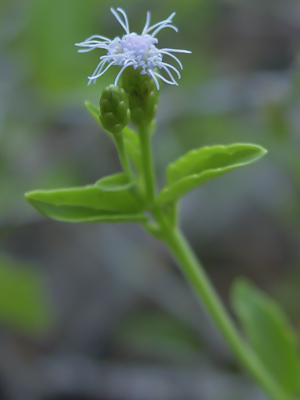Plants of South Florida · Plants by Conservation Area · Plants by County · Plants by Habitat Quick Search · Advanced Search |
||
|
|
||
 |
Chromolaena frustrata (B.L.Rob.)%20R.M.King%20 Cape%20Sable%20thoroughwort |
|
|
South Florida Status: Critically imperiled. Four occurrences in two conservation areas (Lignumvitae Key Botanical State Park; Long Key State Park) and three non-conservation areas (Big Munson Island; North Layton Hammock; Teatable Hammock). Taxonomy: Dicotyledon; Asteraceae. Habit: Perennial terrestrial herb. Distribution: Endemic to South Florida. South Florida Distribution: Monroe County. South Florida Habitats: Coastal rock barrens, edges of rockland hammocks, and coastal berms. Protection Status: Listed as endangered by FDACS and as critically imperiled by FNAI. Currently under review for listing by USFWS (2001). Aids to Identification: Chafin (2000) has illustrations and a color photo. References: Chapman, 1883; Small, 1933a; Ledin, 1951; Long & Lakela, 1976; Avery & Loope, 1980a; Cronquist, 1980; Wunderlin, 1998; Bradley & Gann, 1999b; Chafin, 2000; Coile, 2000. Synonyms: Eupatorium frustratum B.L. Rob.; Eupatorium heteroclinium Griseb., misapplied; Osmia frustrata (B.L. Rob.) Small. Historical Context: John Loomis Blodgett first collected Florida Keys thoroughwort between 1838 and 1853 on Big Pine Key (s.n., NY). Frank C. Craighead collected it again on Big Pine Key in 1955 (s.n., FLAS), but it has not been recorded there since that time. Allan H. Curtiss collected the type specimen in the late 1800s on Lignumvitae Key (1195, NY, GH, FLAS), now within Lignumvitae Key Botanical State Park. It has been collected and observed there a number of times, including by George N. Avery in 1964 (Avery’s Notes, 7 March 1964), by C.P. Sreemadhaven in 1971 (4906, USF), and by Bradley in 1995 (458, FTG). Gann and Florida Park Service biologist Janice A. Duquesnel observed fewer than 100 plants there in 2000. Alvan W. Chapman made another early collection in 1875 on Long Key (20023, US), where two extant stations are known. The first is at Long Key State Park, where Ann Buckley and Ted Hendrickson first vouchered it in 1986 (322, FTG). Gann and Duquesnel observed fewer than 100 plants there in 2000. In 1998, Bradley observed Florida Keys thoroughwort on Long Key on the edge of privately owned North Layton Hammock. In 1892, Joseph H. Simpson made the first collection on Upper Matecumbe Key (565, NY). John Kunkel Small and Nathaniel L. Britton made a collection there in 1919 (9329, NY), Craighead made another collection there in 1962 (s.n., USF), and Olga Lakela vouchered the station again in 1968 (31601, FTG, USF). Plants are extant on Upper Matecumbe Key on the edge of privately owned Teatable Hammock, where Bradley observed them in 1998. Fewer than 10 plants were seen. Florida Keys thoroughwort also was collected and observed at a number of sites in the Florida Keys where it is apparently extirpated. John H. Davis, Jr. made a collection in 1940 on Boca Grande Key (s.n., FLAS), which is located to the west of Key West in what is now Key West National Wildlife Refuge. Gann and Bradley surveyed this island in 1996, but did not observe any plants. Avery observed plants on Knight’s Key in 1962 (Avery’s Notes, 21 November 1962), a station that was vouchered in 1979 by Donovan S. Correll (50973, FTG, USF). Harold N. Moldenke made a collection on Lower Matecumbe Key in 1930 (623, NY), and Walter M. Buswell collected a single specimen on Key Largo in 1930 (s.n., FTG). In 2001, Bradley made a collection on Big Munson Island where it was abundant in rockland hammocks and a coastal rock barren (2128, FTG). This site is owned by the Boy Scouts of America. Small (1918, 1919) reports finding this in 1916 at “Madeira,” to the east of Flamingo in what is now Everglades National Park. Small and John B. DeWinkeler vouchered a population between West Lake and Flamingo in 1921 (9995, NY). George N. Avery observed it twice in that region in 1977, once on the west side of Buttonwood Canal, and once south of West Lake (Avery’s Notes, 9 May 1977, 10 May 1977). R. Bruce Ledin made two collections to the west of that area in 1947, the first from “Stream Bank, above Cape Sable” (s.n., FLAS) and the second from “Cape Sable” (s.n., FTG). Harold N. Moldenke (1944) also reported it for the Turner River Mound in the Ten Thousand Islands area in Everglades National Park, but this station apparently was never vouchered. Despite Avery & Loope’s statement that it could be quite common on the mainland in Everglades National Park (Avery & Loope, 1980a), it may be extirpated there (Reimus, 1999). Major Threats: Exotic pest plant invasions; habitat destruction; management error; sea-level rise. Comments: At Lignumvitae Key Botanical State Park, Florida Keys thoroughwort apparently is now limited to a small area immediately adjacent to a trail that is regularly mowed. It was formerly known from around the historic house. Gann and Duquesnel were unable to locate plants near the historic house in recent surveys, and it may have been extirpated there through the regular mowing and “weed-eating” of the area. Extreme care should be exercised to prevent the loss of Florida Keys thoroughwort from its type locality. Recommendations: • Voucher plants at Teatable Hammock. • Survey Cape Sable region of Everglades National Park. • Encourage USFWS to list Chromolaena frustrata. • Map and monitor known stations on a regular basis. • Acquire North Layton Hammock and Teatable Hammock. • Develop conservation agreement with Boy Scouts of America to manage a viable population of Florida Keys thoroughwort on Big Munson Island, and provide technical assistance. • Prevent extirpation at Lignumvitae Key Botanical State Park. • Consider establishing an ex situ collection of germplasm. • Conduct conservation biology and conservation horticulture studies. • Consider introducing Florida Keys thoroughwort to other sites within its historical range, including the Klopp Tract, Lignumvitae Key Botanical State Park on Lower Matecumbe Key. |
||



